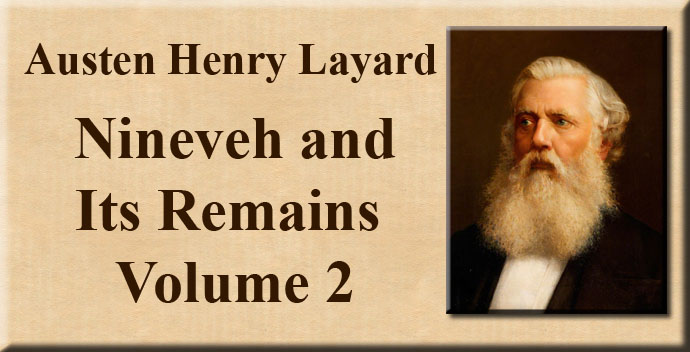
Nineveh and Its Remains
Volume 2
By Austen Henry Layard, ESQ. D.C.L.
Table of Contents
|
TITLE PAGE LIST OF PLATES, WOODCUT, AND PLANS.
PART I. CHAPTER XI. Death of Tahyar Pasha. Excavations carried on. Discoveries in the North-west Palace. New Chambers and Bas-reliefs. Ivory Ornaments and Cartouches with Hieroglyphics. Painted Chambers. Pottery. Discovery of upper Chambers. Paintings on the Walls. Pavement Slabs. Discoveries in the Centre of the Mound. Tombs containing Vases and Ornaments. Their Egyptian Character. Bas-reliefs collected together. Description of the Sculptures. Further Discoveries in the South-west Edifice. Crouching Sphinxes. Sculptures. A Description of the Bas-reliefs. Small Figures in unbaked Clay. A Beam of Wood. Discovery of more Tombs in the South-east Corner — of Chambers beneath them — of an arched or vaulted Room. Discoveries in various Parts of the Mound. CHAPTER XII. Excavations undertaken at Kalah Sherghat. Departure for the Ruins. Senidij. The Bitumen Pits. Abd'rubbou. My Reception. Reach the Ruins. Fears of the Workmen. Discovery of a sitting Figure. Arab Encampment. Arab Life. Excavations in the Mound. Discovery of Tombs. Remains of Building. Description of the Mounds. Return to Nimroud. CHAPTER XIII. System of Irrigation adopted by the ancient Assyrians. Want of Rain. Fears for the Crops. Preparations for the Removal of a winged Bull and winged Lion. Construction of a Cart. Surprise of the Natives. Discovery of a Bas-relief — of a Drain. Lowering of the winged Bull. Its Removal from the Ruins. Excitement of the Arabs. Rejoicings in the Village. The Bull dragged down to the River. The Removal of the Lion. Discontent amongst the Arabs. They leave the Ruins. Rafts prepared for the Transport of the Sculptures to Busrah. The Lion and Bull placed upon them. Their Departure from Nimroud. Return of the Arabs. Excavations commenced in the Pyramid. Conclusion of the Excavations at Nimroud. General Description of the Ruins. CHAPTER XIV. Excavations planned at Kouyunjik. Leave Nimroud. Remove to Mosul. Discovery of a Building in Kouyunjik. Bas-reliefs. General Description of the Sculptures. Excavations carried on by Mr. Ross. His Discoveries. Bas-reliefs. A sculptured Slab and Sarcophagus. Preparations for my Return to Constantinople. Leave Mosul.
PART II. CHAPTER I. Materials for the History of Assyria. Comparative Dates of Monuments. Assyrian Writing. The Cuneiform. Its Varieties. Assyrian Records. Writing Materials. Monumental Records. Bricks and Tiles. Progress in Deciphering. Assyrian Monuments of various Periods. The Ivory Ornaments. Cartouches. Connection between Assyria and Egypt. Historical Evidence of Period of Ninus. The Assyrian Dynasties. The Tombs at Nimroud. Antiquity of Nineveh. CHAPTER II. Semitic Origin of the Assyrians. Identification of the Site of Nineveh. Dimensions of the City. Architecture of the Assyrians. Their first Cities. Building Materials. Sun-dried Bricks. Alabaster. Painted Walls. The Roof and Ceiling. Knowledge of Vaulting and the Arch. Pavement and Drains. Description of an Assyrian Palace. The sculptured and pictorial Records. The Nature of the Buildings discovered in Assyria. Exterior Architecture. Private Houses. Absence of the Column. Walls of the Cities. Their Towers and Gateways. CHAPTER III. The Arts amongst the Assyrians. Their Origin. Connection between Assyrian and Greek Art. The Assyrian Origin of Persian Art. Its Passage into Asia Minor. The Lycian Sculptures. Various Greek Ornaments and Forms borrowed from Assyria. Taste of Assyrians displayed in Embroideries, Arms, and personal Ornaments — in domestic Furniture — in Vessels of Gold and Silver. Paintings. Ezekiel's Description of painted Bas-reliefs. Colours used by the Assyrians. Their Dyes. Materials for Sculpture. Alabaster or Mosul Marble. Limestone and Basalt. Knowledge of Mechanics. The Pulley. Mode of Transport of Blocks of Stone. CHAPTER IV. Costume of the Assyrian Kings. Their Arms. The Eunuchs. Their Dress. The History of Parsondes. Officers of State. The Warriors. Their Armour. Their Costume. Spearmen. Archers. Helmets. Arms. Slingers. Shields. Regular Troops. Chariots. Harness and Caparison of the Horses. Cavalry. Horses. CHAPTER V. Military System of the Assyrians. Magnitude of their Armies. Their Pomp. Sieges. The Battering-ram and other Engines of War. Mode of Defence. Scaling the Walls. Sack of a City. Treatment of the Captives and of the City. Knowledge of Shipbuilding. Earliest Vessels. Later Vessels, as represented at Khorsabad and Kouyunjik. Enemies of the Assyrians — distinguished by their Dress. Armenians and Parthians or Persians. Captives and Tribute from India. The Arabs. The Jews. The Babylonians. The Phoenicians. Northern Nations. Identification of Enemies of the Assyrians with those of the Egyptians. CHAPTER VI. Private Life of the Assyrians. Public Festivals. Music. Manu factures. Embroideries and Carpets. Metals. Gold and Silver. Iron and Copper. Ivory. Glass. Agriculture. Domestic Animals. Wild Animals. The Lion. The Wild Bull. The Ibex. Hunting. Parks or Paradises. Wild Animals brought as Tribute. The Bactrian Camel, Elephant, and Rhinoceros. Monkeys and Apes, Birds. Fish. Trees. CHAPTER VII. Religion of the Assyrians. Distinctions between earliest and latest Periods. Sabaeanism and Worship of the Heavenly Bodies. Identity of Assyrian and Persian Systems of Fire-worship. The Chaldoeans. Religious Emblems in the Sculptures. The winged Figure in the Circle. Baal or Belus. Hera, Venus, or Astarte. Rhea. Nisroch or Eagle-headed God. The Gryphon. Winged Bulls and Lions. The Sphinx. Mythological Figures. Symbolic Figures of Ezekiel. Cannes or the Man-fish. Fire-worship. The Magi. Flowers and sacred Emblems. Influence of Religion on public and private Life. Mode of Burial. Tomb of Ninus. Death and Tomb of Sardanapalus. Conclusion.
|
|
 |
 |
|
|
|
-
Site Navigation
 Home
Home What's New
What's New Bible
Bible Photos
Photos Hiking
Hiking E-Books
E-Books Genealogy
Genealogy Profile
Free Plug-ins You May Need
Profile
Free Plug-ins You May Need
 Get Java
Get Java.png) Get Flash
Get Flash Get 7-Zip
Get 7-Zip Get Acrobat Reader
Get Acrobat Reader Get TheWORD
Get TheWORD